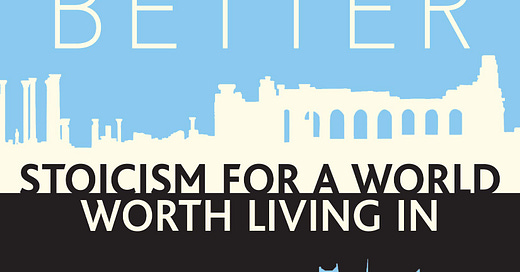A Review of Being Better: Stoicism for a World Worth Living In, by Kai Whiting and Leonidas Konstantakos
Being Better: Stoicism for a World Worth Living in by Kai Whiting and Leonidas Konstantakos is unique and great introductory book on Stoicism. Many books on Stoicism written for a popular audience focus on the individual, on being resilient, on using Stoicism to get “successful” in life. Being Better instead focuses on Stoicism as a way of life, focusing on virtue and reason, living according to nature, and the concept of the cosmopolis. The book paints a picture of what living a Stoic life means in today’s world. It is straightforward and simple enough that someone with no familiarity could pick it up and learn much from it, but also well researched and detailed enough to provide new insights for those already familiar with Stoicism. I have been learning and applying Stoicism to my life for over three years and found quite a lot to learn from in the book.
Each of the chapters focus on an important concept in Stoicism. A couple of my favourites were chapter 6’s Put People In Circles, Not Boxes and chapter 8’s Living According to Nature. Each chapter also brings examples from different ancient Stoics, many of whom are rarely covered in contemporary Stoicism books such as Sphaerus and Panaetius. Providing examples of how they used Stoic principles to affect change in their lives such as Sphaerus working with Kleomenes to reform Sparta through education and an increased importance on citizenship and community through reforms.
Modern exemplars are also highlighted each chapter which really help show that it isn’t just the Stoics from Hellenistic times who can show us how to live a Stoic life. Each of the modern examples does a good job of showing what the chapters principle looks like in a modern context. A notable example for me was the choice of Pat Tillman and Katharine Gun as role models of virtuous action. Both were effectively on different sides of the Iraq War. Tillman, an up-and-coming NFL star who turned down millions and the safety of playing in the NFL to enlist in the US army in the Iraq and Afghanistan wars, and further refused the offer to keep him out of harm’s way because of his superstar status. Gun, a member of the British secret service, put her freedom and reputation at stake when she leaked a top-secret memo from the NSA exposing intent to blackmail UN Council members to legalize the Iraq War. These to different examples show an important part of Stoicism, appropriate or virtuous action is contextual.
This was further pointed out in Panaetius’ concept of four roles; our primary role being that of rational human beings, then our individual natures, next our personal circumstances, and finally the professional path we take in life. These four roles highlight the importance of considering individuals and what they can do for the good of themselves and their communities. It was also a concept that was new to me and is another way of looking at virtue and determining what we can best do with our life to improve it and those around us.
Each chapter also ends with a question or two inspired by the example of the Stoic covered in the chapter, these provide good prompts for us to think how we could apply Stoic principles into our day-to-day lives and make progress towards being better ourselves. I have saved these to my Evernote account and plan to use them on occasion to prompt a journal entry.
The book begins with the chapter The Promise of the “Good Life” and ends with chapter Well on the Way to a Life Transformed, and I think that is fitting. By the end of the book the reader should have a good idea whether Stoicism is something that can transform their life and is something worth pursuing further. And as someone who has had Stoicism transform their life for the better I believe there is something that nearly everyone can benefit from in learning it, and this book is a great place to start.
Virtue does not exist in a vacuum, and therefore it cannot be contained in the mind of the person who works on being better. Instead, a virtuous action is like a stone thrown into a lake—the impact causes a ripple effect that extends far and wide, touching shores that can’t be seen. This is why Stoicism isn’t really about personal development but rather the effort made to know who you are and what you must do to create a harmonious world.
-Being Better, Kai Whiting & Leonidas Konstantakos, p. 133





I like the direction that Kai & Leo, Brittany Polat, And David Fideler seem to be pushing Modern Stoicism in.